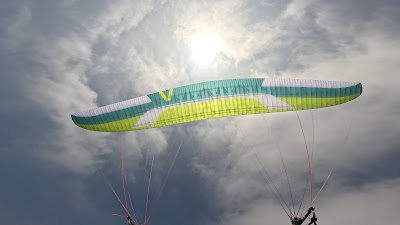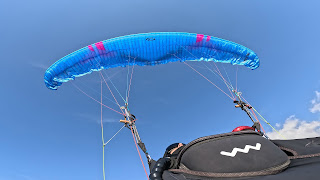SKYWALK Mint 75-95
The Mint is Skywalk’s new 2-liner C-class glider with an aspect ratio of 6.4. The Mint looks very simple with nice and sturdy risers. There are no complications in the setup, just simple and clear. Skywalk uses the Dominico TX light which has a unique feel, is slippery on the touch, and less noisy when packed.
The Mint launches even in nil wind with easy rise. After 75, it accelerates a bit as the leading edge takes charge, and the pilot must hold it with the brakes and initiate the takeoff.
The brakes have a 10 cm gap, before there’s an action on the trailing edge, which is the normal gap for paragliders to be able to reach the top speed without braking, then only 5 cm are needed to steer that glider in moderate conditions! But the brake pressure is a bit hard comparing it to the Photon, Artik-R, and Volt. The authority on the brakes is imminent! The turn is quickly induced by the brakes. I would say there’s no linear feel, but a direct one for sure. The pressure after the first neutral 10 cm becomes a bit hard or firm for some pilots who require that feel of solidity on the brakes. The feel is steady for the first 5 cm. The feel is direct rather than linear, but the brake authority is quite high.
Flying the Mint, I could put it in very narrow cores with imminent brake input, and there’s no way you could miss a thermal with that brake authority and glider obedience. The good thing is that there’s no pitch back at all, and also not any pitch forward. I think for moderate conditions, the Mint has a very neutral pitch behavior, but it felt quite efficient going into the valley breeze or into wind conditions. It felt that it goes forward quite nicely. In difficult conditions when you need to get through the airmass, I think there’s a nice efficiency for the Mint to get through without bumping into it. But I think if flown at 95 all up at its max weight range, you will feel its good slipping through when you are low facing a valley breeze. You can fly it at 90 all up, but it wouldn’t be as efficient to slip through the heavy airmass as loaded at the top in those specific conditions. At max load, the mint still does climb very well even in weak.
The first speed bar enhances even that glide into the wind, as it felt more solid, and also has better float ability. The controls on the B’s are really efficient and nice, much like the ones on the Artik-R. The pressure is moderate, and it felt while on the bar, in turbulence when pulling on the B risers, the glider supports it well still very homogenous, and without too much loss of internal pressure. Overall a nice complete setup.
In turbulence, I think the Mint is very close to the Bonanza 3 overall comfort. +5 % more than B3. The Artik-R moves a bit more in turbulence and needs around 10 % more pilot control than the Mint. I think I gave you a good idea about its accessibility, but for sure, my (regularly updated) C comparison will give you a wider idea for pilots looking
for tiny details.
It doesn’t have a pronounced roll feel but a moderate one.
Climbing in weak thermals, showed me a very nice efficiency for the Mint even at 94 all up, and could be very close to the best climbing ones in the C category. The turning radius could be very tight, and to prevent the dive it is best to control the turn with the outside brake and keep the inside one locked.
In climbing mode, it is difficult to miss a thermal. if the pilot learns well to keep it from diving into turns, by applying a balance of less brake pressure and weight shift, as much as possible to get quick but flat turns.
Doing some glides next to a Volt 4, Artik-R, and Photon, at trim and at top speed, showed me that the overall gliding performance is very good for that category, and will update my C comparison for smaller details if needed…
The top speed of the mint is also similar to the Volt 4 top speed which is really good, and fast and still with a solid leading edge.
Conclusion:If you are a Cayenne 4 pilot, you will feel much better sail cohesion and much shorter brake travel under the Mint. If you are a Cayenne 5 pilot, you will get a more comfortable glider with very good agility in turns. If you have a Cayenne 6…Hurry and get the Mint, as it is a completely different glider in all aspects! It turns sharper, quicker, better overall gliding performance, and better climb in weak and strong.
Compared to the already flown 2-liner C gliders, I found that it has a strong package for C pilots flying in strong conditions where you need a fast, agile, but comfortable glider to fly XC without getting tired under turbulence.






































